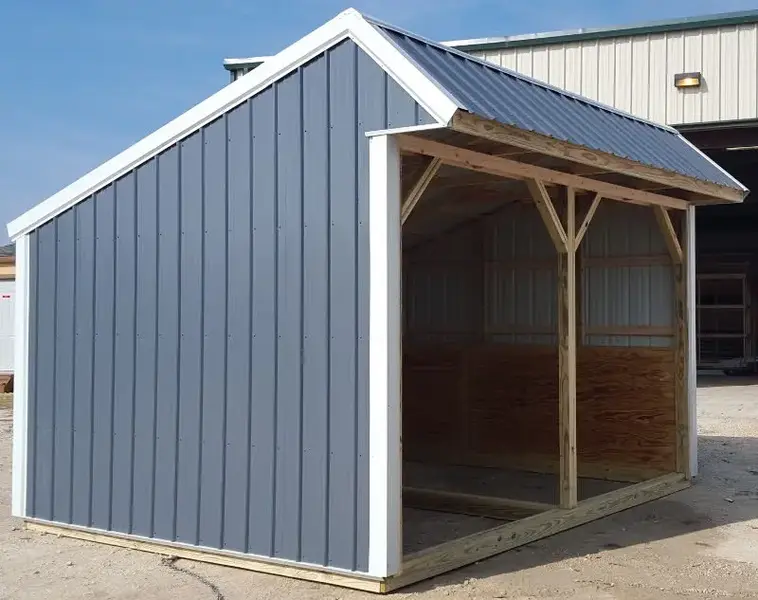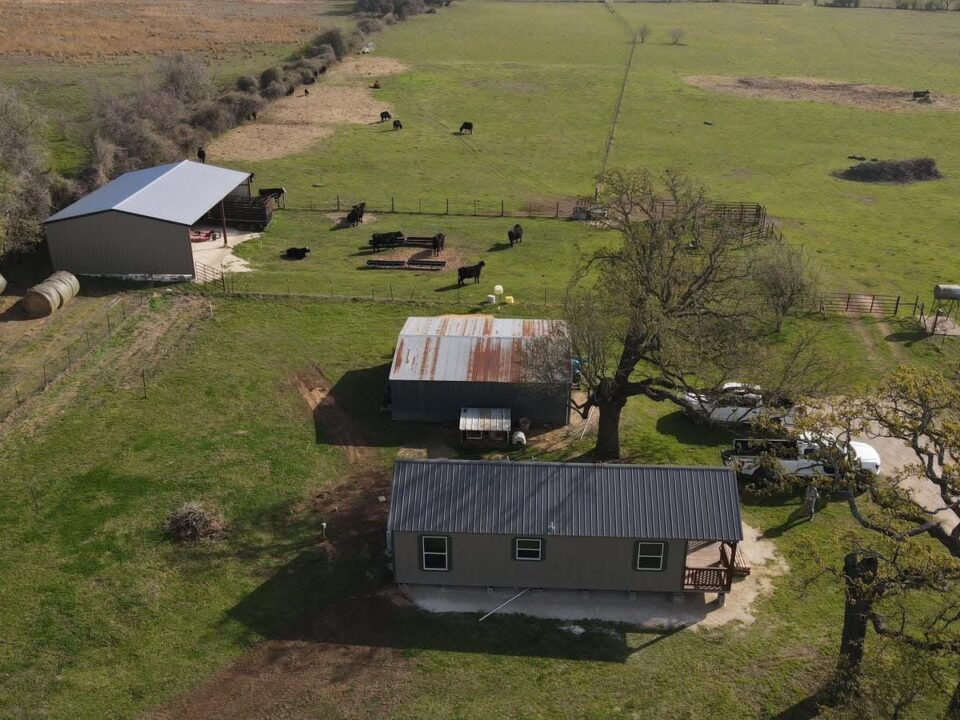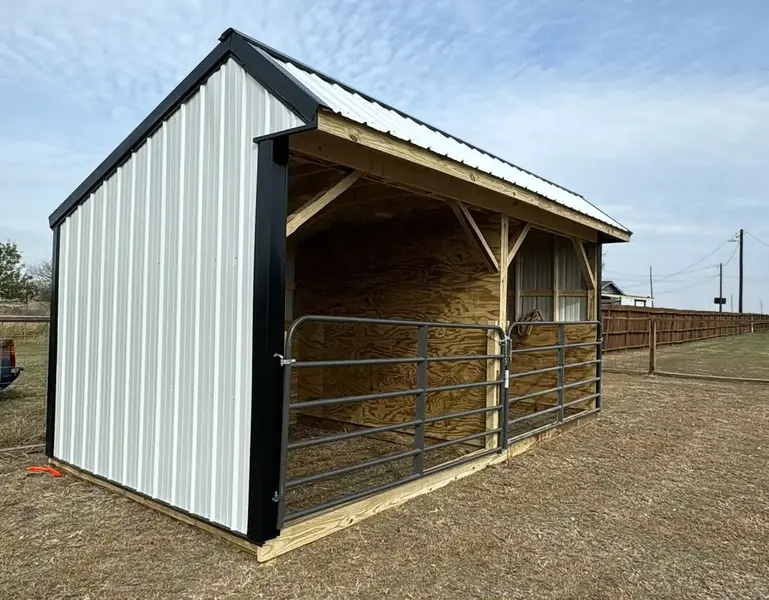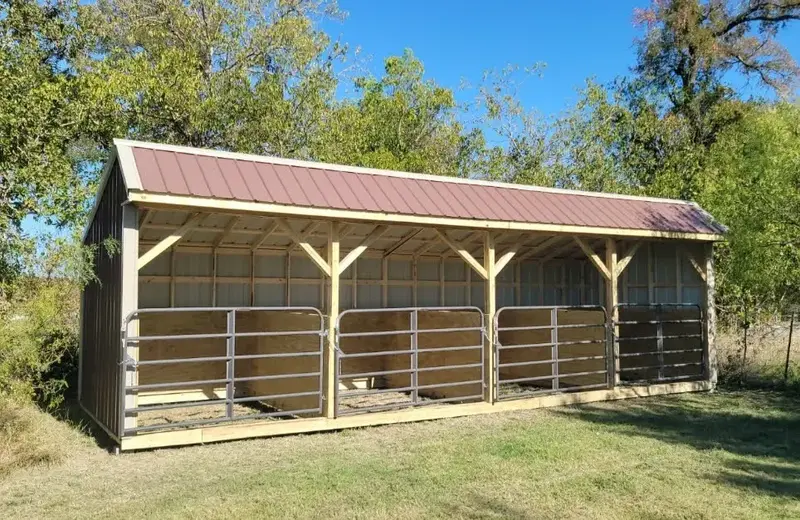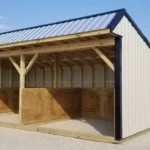
Goat Shelter for Summer: Why Every Herd Needs One
July 12, 2025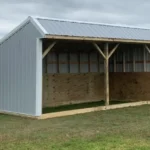
Animal Shelter Cleaning Tips
July 14, 2025Choosing the Right Loafing Shed for Your Property
If you’re raising livestock or caring for outdoor animals, a loafing shed can make a significant difference in their comfort, health, and safety. These simple yet functional shelters provide year-round protection and can be customized to match your specific needs. Whether you’re housing horses, cattle, goats, or even a backyard donkey, selecting the right loafing shed is about more than just size—it’s about fit, function, and future planning.
Let’s walk through the essentials of choosing the perfect loafing shed for your animals and land.
What Is a Loafing Shed?
A loafing shed is a three-sided structure that stays open on one long side, offering animals an easy place to find shelter from wind, rain, sun, and snow. It’s perfect for pasture-based care, allowing your animals to move freely while still having a dry, shaded place to rest.
These sheds are particularly useful in rural areas like Texas, Oklahoma, and Arkansas, where weather patterns can shift quickly and leave animals exposed without proper shelter.
Size and Layout Matter More Than You Think
When selecting a loafing shed, it’s important to think beyond how many animals you have. Different animals behave in different ways. Horses need ample room to move around comfortably without feeling trapped or aggressive. Cattle often bunch together in shady areas, creating competition for space. Goats and sheep are more likely to settle in cozy corners, but they still need airflow and space to spread out during extreme heat or storms.
If you’re housing just one horse, for example, you’ll want at least a 12-by-12-foot space. Cattle and donkeys tend to require more width to turn and lie down comfortably, while smaller animals like goats can thrive in tighter quarters as long as the structure is dry and well-ventilated. If you plan to grow your herd or introduce new animals later, it’s smart to size up now to avoid having to expand later.
Site Prep and Placement
Even the best-built loafing shed won’t serve its purpose if it’s installed in the wrong spot. Choose a slightly elevated area that drains well to prevent water pooling or deep mud buildup after a rainstorm. The open side of your loafing shed should face away from prevailing winds, but you’ll also want to consider how your animals travel across the land throughout the day.
Sunlight matters too. In hot climates, it’s wise to face the opening away from the blazing afternoon sun. In colder climates, orient the shed to catch morning sun and warm the space naturally. Preparing a level dirt or gravel base will go a long way in extending the life of your loafing shed and reducing wear and tear on your animals’ hooves.
What Materials Make the Best Loafing Sheds?
When it comes to housing large animals, durability should be a top priority. At Wolf Valley Buildings, we construct loafing sheds with sturdy wood framing that holds up over time, along with metal roofing that resists wind and water damage. Interior kickboards are recommended for animals like horses and cattle to protect the walls from impact. Some owners choose to add roof overhangs to offer extra protection from sun or rain.
While it may be tempting to repurpose an old structure or build something temporary, a well-designed loafing shed is a long-term investment in both the safety of your animals and the efficiency of your property.
Do You Need Enclosures or Add-Ons?
Depending on your setup, certain customizations can make a loafing shed even more functional. Some sheds include feed storage rooms, sliding gates, or partial side walls that help manage animal behavior and improve the flow of movement. These options are especially helpful if you need to separate animals for feeding or medical care, want to lock up tack or feed, or need additional shade or windbreaks.
At Wolf Valley Buildings, we’re happy to build in the features that match your operation—whether you’re working with a small homestead or a larger pasture-based system.
Long-Term Value and Animal Health
A properly built loafing shed doesn’t just shelter animals—it improves their health over time. By staying dry, animals are less prone to illness. Feed lasts longer when protected from rain and wind, and bedding stays cleaner. This translates to lower costs, fewer injuries, and less stress—for both your animals and your wallet.
The long-term value of a loafing shed is about more than just convenience. It’s a proactive investment in animal care that also reduces your daily workload and protects your land from damage due to overgrazed or muddy patches.
Final Thoughts: Choose Smart, Build Strong
Choosing a loafing shed means choosing to make your animal care more sustainable, efficient, and humane. Take time to consider your animals’ size, behavior, and shelter needs before settling on a design. And don’t forget to think a few years ahead—animals grow, herds expand, and land conditions shift.
If you’re ready to choose or customize a loafing shed that works as hard as you do, our team at Wolf Valley Buildings is here to help. We’ll walk you through your options, recommend materials that last, and help you plan the perfect placement.
👉 Let’s get started today. Reach out for a quote or site prep consultation.
Best Roofing and Siding for Animal Shelters
Best Animal Shelter Flooring for Harsh Climates | 2025 Guide
Predator-Proof Animal Shelter | 2025 Safety Upgrades
External Link:
https://extension.okstate.edu/fact-sheets/livestock-comfort-and-shelter.html

